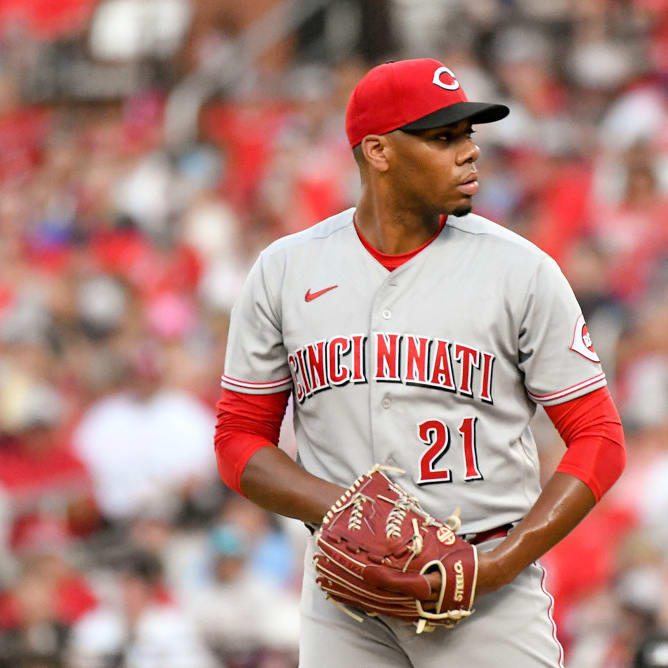This article is part of our The Z Files series.
One of the popular topics of conversation at the First Pitch Arizona conference, as well on the Twitterverse, is how to approach pitching in 2022 drafts. Most cite the paradigm between starter and reliever usage and how this influences the balance between ratios and compiling ample wins and saves.
Welcome to the party, pal.
Astute fantasy managers sensed the shift heading into the 2021 campaign. To help manage pitching on a weekly basis, I ranked a reliever (non-closer) with the scheduled starters in the Weekly Pitching Rankings. The notion was that using a reliever of this ilk should be considered over any starters lower in the ranks. What follows is a review of the results, with an eye on how to improve the process for the upcoming season.
By means of a quick review, based on impending matchups, each probable pitcher's week is projected, then ranked based on how they'll affect a fantasy team's stats for the scoring period. The following relievers were included each week:
| Pitcher | IP | ERA | WHIP | K/9 |
|---|---|---|---|---|
| MIX12 Reliever | 3 | 3.00 | 1.10 | 12.00 |
| MIX15 Reliever | 3 | 3.20 | 1.14 | 10.80 |
| AL Reliever | 3 | 3.50 | 1.20 | 9.00 |
| NL Reliever | 3 | 3.50 | 1.20 | 9.00 |
Let's start with deciding if the weekly inventory supported finding a reliever of this nature. That is, was the choice of reliever realistic?
Here are the non-closing relievers most closely matching this criteria, ranked by descending ERA, though the columns can be sorted:
| Pitcher | IP | ERA | WHIP | K/9 | W | SV |
|---|---|---|---|---|---|---|
| Trevor Richards | 64.33 | 3.50 | 0.96 |
One of the popular topics of conversation at the First Pitch Arizona conference, as well on the Twitterverse, is how to approach pitching in 2022 drafts. Most cite the paradigm between starter and reliever usage and how this influences the balance between ratios and compiling ample wins and saves.
Welcome to the party, pal.
Astute fantasy managers sensed the shift heading into the 2021 campaign. To help manage pitching on a weekly basis, I ranked a reliever (non-closer) with the scheduled starters in the Weekly Pitching Rankings. The notion was that using a reliever of this ilk should be considered over any starters lower in the ranks. What follows is a review of the results, with an eye on how to improve the process for the upcoming season.
By means of a quick review, based on impending matchups, each probable pitcher's week is projected, then ranked based on how they'll affect a fantasy team's stats for the scoring period. The following relievers were included each week:
| Pitcher | IP | ERA | WHIP | K/9 |
|---|---|---|---|---|
| MIX12 Reliever | 3 | 3.00 | 1.10 | 12.00 |
| MIX15 Reliever | 3 | 3.20 | 1.14 | 10.80 |
| AL Reliever | 3 | 3.50 | 1.20 | 9.00 |
| NL Reliever | 3 | 3.50 | 1.20 | 9.00 |
Let's start with deciding if the weekly inventory supported finding a reliever of this nature. That is, was the choice of reliever realistic?
Here are the non-closing relievers most closely matching this criteria, ranked by descending ERA, though the columns can be sorted:
| Pitcher | IP | ERA | WHIP | K/9 | W | SV |
|---|---|---|---|---|---|---|
| Trevor Richards | 64.33 | 3.50 | 0.96 | 10.91 | 7 | 1 |
| Bryan Shaw | 77.33 | 3.49 | 1.38 | 8.26 | 6 | 2 |
| Ryne Stanek | 68.33 | 3.42 | 1.21 | 10.93 | 3 | 2 |
| Steve Cishek | 68.33 | 3.42 | 1.49 | 8.43 | 0 | 0 |
| Gregory Soto | 63.67 | 3.39 | 1.35 | 10.74 | 6 | 18 |
| Brad Boxberger | 64.67 | 3.34 | 1.07 | 11.55 | 5 | 4 |
| Caleb Thielbar | 64.00 | 3.23 | 1.17 | 10.83 | 7 | 0 |
| Tyler Duffey | 62.33 | 3.18 | 1.22 | 8.81 | 3 | 3 |
| Brett Martin | 62.33 | 3.18 | 1.30 | 6.06 | 4 | 0 |
| Chad Green | 83.67 | 3.12 | 0.88 | 10.65 | 10 | 6 |
| Paul Sewald | 64.67 | 3.06 | 1.02 | 14.47 | 10 | 11 |
| Jose Ruiz | 65.00 | 3.05 | 1.17 | 8.72 | 1 | 0 |
| Josh Staumont | 65.67 | 2.88 | 1.07 | 9.87 | 4 | 5 |
| Anthony Bender | 60.33 | 2.83 | 1.08 | 10.44 | 3 | 3 |
| Dylan Floro | 64.00 | 2.81 | 1.22 | 8.72 | 6 | 15 |
| Craig Stammen | 80.33 | 2.80 | 0.95 | 8.74 | 6 | 1 |
| Brent Suter | 71.00 | 2.79 | 1.28 | 8.49 | 12 | 1 |
| Ryan Tepera | 61.33 | 2.79 | 0.88 | 10.86 | 0 | 2 |
| Cole Sulser | 63.33 | 2.70 | 1.12 | 10.37 | 5 | 8 |
| Lucas Luetge | 70.33 | 2.69 | 1.14 | 9.85 | 4 | 1 |
| Jarlin Garcia | 68.67 | 2.62 | 0.96 | 8.91 | 6 | 1 |
| Tyler Matzek | 63.00 | 2.57 | 1.22 | 11.00 | 0 | 0 |
| Luis Cessa | 64.67 | 2.51 | 1.14 | 7.52 | 5 | 0 |
| Scott Barlow | 74.33 | 2.42 | 1.20 | 11.02 | 5 | 16 |
| Zack Littell | 60.67 | 2.37 | 1.04 | 9.20 | 4 | 2 |
| Adam Cimber | 71.67 | 2.26 | 1.07 | 6.40 | 3 | 1 |
| David Bednar | 60.67 | 2.23 | 0.97 | 11.42 | 3 | 3 |
| Tyler Rogers | 81.00 | 2.22 | 1.07 | 6.11 | 7 | 13 |
| Jonathan Loaisiga | 70.67 | 2.17 | 1.02 | 8.79 | 9 | 5 |
| Jose Alvarez | 63.00 | 2.14 | 1.05 | 6.00 | 5 | 0 |
| Drew Steckenrider | 67.67 | 2.00 | 1.02 | 7.71 | 5 | 14 |
| Blake Treinen | 72.33 | 1.99 | 0.98 | 10.58 | 6 | 7 |
| Luke Jackson | 63.67 | 1.98 | 1.16 | 9.89 | 2 | 0 |
| Garrett Whitlock | 73.33 | 1.96 | 1.10 | 9.94 | 8 | 2 |
| Andrew Chafin | 68.67 | 1.83 | 0.93 | 8.39 | 2 | 5 |
| Andrew Kittredge | 65.33 | 1.65 | 0.96 | 9.64 | 9 | 8 |
Weekly numbers will vary, but all we can logically do is base expectation on a plausible static projection. With that in mind, the ratios seem reasonable. However, expecting three innings is a tad optimistic. Since this is all coded into Excel, it really doesn't matter what is used.
There are 25 full weeks plus two partial weeks (opening week and All-Star week) so the season is essentially 26 weeks.
IP/WK | Total IP |
|---|---|
3 | 78 |
2.67 | 69.42 |
2.5 | 65 |
2.33 | 60.58 |
Based on the relievers above, 78 innings for the season is high. By eye, 65 innings is best, so long as I can get over my OCD and project a guy for an impossible number of weekly innings. We're picking nits here, so I'll think on it and report the decision with the introductory rankings in the spring.
Strikeout rate also seems high. It's fine for AL and NL-only formats, but aggressive for mixed leagues. Dropping MIX12 to 10.5 and MIX15 to 10.0 makes finding someone meeting the criteria more practical. However, lowering the innings and punchouts also lowers their value, and thus their ranking.
Obviously, wins and saves are both are a crapshoot, especially on a per-week basis. As such, they were excluded from the calculation. In retrospect, this is unfair, so next season they'll be included. That said, if they were incorporated this season, the reliever rankings would have improved (but I don't know to what extent).
Let's shift gears to the actual results and if this approach was helpful. Here is where the relievers landed in the rankings, along with the number of scheduled double-dippers, as of the Sunday night update.
| Pitcher | AVG | High | Low |
|---|---|---|---|
| Mix 12 Reliever | 83.4 | 98 | 72 |
| Mix 15 Reliever | 92.2 | 104 | 80 |
| AL Reliever | 54.2 | 67 | 46 |
| NL Reliever | 50.9 | 57 | 42 |
| Two-starts | 35 | 48 | 23 |
Out of curiosity, I determined the correlation between the mixed rankings and number of two-start pitchers, and it was very low, so the decision on whether to deploy a reliever is independent of the number of pitchers with two starts in a period. Along those lines, please realize the above is based on probable starters following the conclusion of the Sunday night game. As well all know, there were always changes during the week.
Let's assume each team has two closers active each week. Working in a vacuum (which is dangerous, since there is no air, depriving the brain of needed oxygen), here is the average composition of an optimal staff (rounding off):
| Pitcher | SP | CL | MR |
|---|---|---|---|
| Mix 12 Reliever | 7 | 2 | 0 |
| Mix 15 Reliever | 6 | 2 | 1 |
| AL Reliever | 5 | 2 | 2 |
| NL Reliever | 4 | 2 | 3 |
Starting with 12-team mixed, I suspect most prefer deploying seven starters so the results match intuition. However, at least on average, more 15-team managers may force a seventh starter when they shouldn't (raises hand). At least according to this data, a solid middle reliever is more useful than a SP7 more than half of the time.
Something is awry in the only leagues, though. First off, the number of starting pitchers was rounded off. Without that adjustment, the number of starters ranked better than the corresponding reliever was 4.52 in the AL and 4.24 in the NL. Had the AL result been just .03 lower, both would have rounded to 4. However, the difference in rounding is serendipitous.
Better starting pitching requires fewer middle relievers. This is evident in the mixed leagues. The ERA for NL starters was 4.22 as compared to 4.46 for their AL counterparts. Granted, we're talking decimals, but there should be slightly more NL active starters, but the above has it reversed.
There are several explanations, beginning with the possibility the AL projections could have been too high. However, there is a more basic theory: perhaps NL relievers were slightly better than the AL ones? As is, they're the same. The catch is, AL relievers as a group posted a slightly better ERA (4.15) than those in the NL (4.19).
We're beginning to split hairs, not to mention the likelihood of the universal DH the next time I post Weekly Pitching Rankings will skew the current dynamic, so it's best not to get caught up in what appears to be a small glitch in the numbers.
More importantly, for those still staying with their fantasy baseball roots and competing in single leagues, four or five starters could be the optimal weekly target. Of course, the ability to meet an innings minimum needs to be considered, but a 4-2-3 deployment should conservatively yield at least 900 innings (4x150 + 5x60). The starter and reliever inventory support this approach, though sage player acquisition is obligatory.
To this point, the analysis has been assuming an average number of relievers per week. Let's check out the extremes, beginning with the lowest each reliever was ranked over the course of the season.
| Pitcher | Rank | SP | CL | MR |
|---|---|---|---|---|
| Mix 12 Reliever | 98 | 8 | 1 | 0 |
| Mix 15 Reliever | 104 | 7 | 2 | 0 |
| AL Reliever | 67 | 6 | 2 | 1 |
| NL Reliever | 57 | 5 | 2 | 2 |
As expected, fewer middle relievers are needed when more starters are ranked ahead of them. The interesting part is in the only leagues, at least one MR is still optimal every week. Hmm, it's time to stop believing I can pull off seven starters with two closers in AL LABR and NL Tout. My recent record corroborates this epiphany.
Here is the other end of the spectrum:
| Pitcher | Rank | SP | CL | MR |
|---|---|---|---|---|
| Mix 12 Reliever | 72 | 6 | 2 | 1 |
| Mix 15 Reliever | 80 | 5 | 2 | 2 |
| AL Reliever | 46 | 4 | 2 | 3 |
| NL Reliever | 42 | 4 | 2 | 3 |
There was at least one week it behooved a manager in a 12-team league to start a middle reliever. This poses the question, how many times should a middle reliever have been deployed in each format?
0 | 1 | 2 | 3 | |
|---|---|---|---|---|
| Mix 12 Reliever | 21 | 4 | 0 | 0 |
| Mix 15 Reliever | 3 | 20 | 2 | 0 |
| AL Reliever | 0 | 1 | 10 | 14 |
| NL Reliever | 0 | 0 | 7 | 18 |
The top line is the number of optimal relievers, so there were four instances out of 25 periods for a 12-team manager to utilize a dominant setup man. There were a whopping 20 times a 15-team manager should have had an active middle reliever, suggesting it was best to have one available as opposed to picking one up each week. That is, every team in a 15-team league should draft one dominant reliever since they should be active 80 percent of the time. Similarly, AL and NL-only team managers should initially roster three non-closing relievers.
One of the benefits of this is akin to a Moneyball approach. Remember, Moneyball wasn't about the importance of OBP, but rather how its usefulness was undervalued by the market. The savings could be funneled elsewhere. This is how LIMA worked. It wasn't just about spending less on pitching that met certain filters, it was all about the minimal cost of those helpful players with the saved budget shifted to hitting.
For those not familiar, LIMA is an acronym for Low Investment Mound Aces. It was the brainchild of friend and colleague Ron Shandler. It was directed more towards starters than relievers (as shown by its namesake, Jose Lima). The idea was that pitchers who met certain criteria were more likely to post palatable ratios. This was back when 4x4 ruled, so part and parcel to the approach was recording just enough innings to eclipse the minimum, helping to keep ratios in check while competing in saves. Wins were left to the whim of the roto deities, but often dovetailed simply from rostering quality arms. Using the LIMA method, only $60 was allotted to pitching, with $200 funding the bats. The typical split was closer to $169/$71. As such, LIMA proponents built pitching just as competitive as others, but bullied a more potent offense with the additional $31 to spend.
When 5x5 began dwarfing 4x4 leagues, middle relievers lost some of their appeal. However, with the shift in pitcher usage, dominant setup men are back in vogue. Since LIMA referred to starting pitchers, a new acronym is needed. The allure of the dominant setup man is back, but the cost remains below market value. LIDS? Low Investment Dominant Setup? Eh, we can do better than that.
To summarize:
- An adjustment is needed for the baseline relievers to better reflect the practical inventory
- Many underestimate the utility of the dominant middle reliever and/or the number needed for the most efficient team management
- It's optimal to leave the draft with at least one solid middle reliever in mixed leagues of over 12 teams, with up to three being ideal in single-league formats
- Not only will incorporating more relievers improve pitching numbers but savings from the lower cost of these assets can applied to starting pitching or hitters
- We need a cool name for the approach
Even with the small flaws in the design of the relievers, the results are eye-opening. For those already incorporating these observations, nice job. I needed this push. Maybe it should have been obvious, but did hitters really need the advent of launch angles and exit velocity to understand hitting more fly balls with added force leads to more homers?










